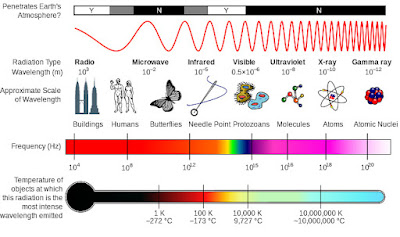When you go outside on a sunny day, you'll feel the heat and brightness of the Sun. These are the everyday experiences we might take for granted, but, the journey which allows us to feel the radiation of the Sun is actually astoundingly complex. It's all started 150 million kilometers away in the searing nuclear furnace at the heart of our local star.
Deep in the Sun's core, the temperatures and pressures are extreme: with the full weight of 2 million trillion trillion kilograms of hydrogen and helium gas bearing down on top of them (the Sun is 333,000 times the mass of the Earth) and almost 16 million degrees Celsius, the collisions between particles are extremely violent. In the centre of the Sun hydrogen nuclei are smashed together with such colossal force that the atoms merge, forming new and heavier atomic nuclei of the element helium. As they fuse, a tiny fraction of the hydrogen nuclei mass is converted into energy in the form of electromagnetic radiation.
The mass of hydrogen atom is incredibly small (~ 600-trillion-trillionth of a kilogram), and the amount of the mass lost to be converted to energy is even tinier (0.7% of the total), but this translates to a substantial amount of energy described in Einstein's famous equation E=mc² because c or the speed of light is the fastest thing in the universe at around 300 million meters per second. If multiplied with the equation, it produces a big number indeed - 90,000 trillion meaning that the energy liberated is considerable.
Every second, 600 billion kilograms of hydrogen are converted into helium inside the Sun with 0.7% of it transformed to 400 trillion trillion electromagnetic radiation (equals to the explosion of 100 billion megatons of TNT every second). Each fusion reaction results in a production of a photon - a unit of electromagnetic radiation. But it's not yet the familiar photon of sunlight the human eyes have evolved to detect, it is gamma ray photon (the most extreme form of electromagnetic radiation with hundreds of thousand of times as much energy as a single photon of sunlight).
Photons can travel over a very large distance in empty space or through some forms of matter like air or gas unimpeded. But at the heart of the Sun, it's full of opaque fog containing charged particles and no photon can travel very far without colliding one of them. After colliding, it will be spat out in a different direction but with less energy, the energy lost is retained by the particle (which maintains immense temperature in the Sun's core).
The collision and energy loss occurs again and again as the photons ricochet randomly. The average distance between successive collision is only about 1 cm, while the solar core is hundreds of thousands of kilometers across. Not to mention that after collision the direction is being altered, it takes an extremely long time for photons to emerge from the core to the outer layers of the sun. The average exit time for photons are 170,000 years!
After that, the photon still has to travel through hundreds of thousands of kilometer of the Sun's outer layers and emerge into space, but this takes only about a week. In the process of their long journey with lots of collisions, the photons have donated a large fractions of energy to the myriad particles they have interacted en route, gradually attenuating them from gamma rays to x-rays and to photons of ever decreasing intrinsic energy. The harsh gamma rays generated in the core have been reduced to 50% infrared radiation, 10% UV radiation, and 40% visible light which streams out into space:
this is sunshine.
 |
| Electromagnetic spectrum. Credit: NASA |
Outside the Sun, it's less dense and the photons can travel to Earth in 8 minutes. In our atmosphere 70% of the UV are absorbed in the ionosphere and ozone layer. Infrared photons are also absorbed by the air, helping to warm it while the rest heat the surface like the land and the sea. The visible light is the range of photon energy that can be detected by the human eye.
When we go outside on a clear day, these electromagnetic radiation strike our body and transfer the energy they carries to the atoms and molecules that make up our cells, then picked up by the temperature receptors in our skin and the light receptors in our retina. These cells then send electrical signals via our nerves to our brain, where they are translated into sensation of heat and brightness.
The heat and light we feel and see is an epic astrophysical journey. The sunshine that warms and illuminates our world was born 170,000 years ago in the heart of the Sun. Like the bones of our earlier ancestors when modern humans had only just evolved in Africa, the photons of sunlight are very much fossils from the distant past.




